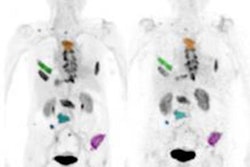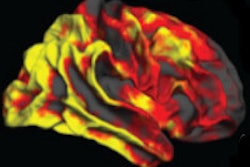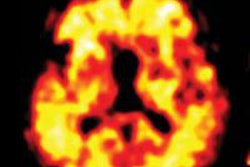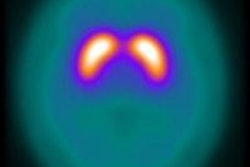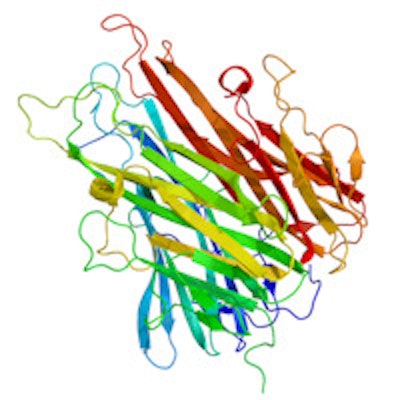
PET scans can detect varying levels of amyloid in the brain that change with age and the presence of a genotype linked to Alzheimer's disease, according to a Dutch study in the May Journal of the American Medical Association. The findings may enable clinicians to better tailor which patients receive the scans.
The study from researchers at VU University Medical Center in Amsterdam found that the average prevalence of abnormal amyloid PET scans among Alzheimer's patients decreased from 93% at age 50 to 79% at age 90. Meanwhile, the average prevalence among those with the apolipoprotein E (APOE) ε4 genotype remained above 90% regardless of age, but in those without the allele, it decreased from 86% at age 50 to 68% at age 90.
Among subjects with Alzheimer's and non-Alzheimer's dementia, the prevalence of amyloid was associated with clinical diagnosis, age, and APOE genotype, the group concluded (JAMA, May 19, 2015, Vol. 313:19, pp. 1939-1949).
"These findings indicate the potential clinical utility of amyloid imaging for differential diagnosis in early-onset dementia," lead author Rik Ossenkoppele, PhD, and colleagues wrote.
Limits of clinical diagnosis
More than 35 million people have some form of dementia, with the beta-amyloid plaque deposits and neurofibrillary tangles associated with Alzheimer's accepted as the most common cause, according to the authors. However, a clinical diagnosis of Alzheimer's disease has been shown to have limited sensitivity, at 71% to 81%, and only 70% specificity.
The development of PET tracers that detect beta amyloid offers the chance to diagnose Alzheimer's disease at an earlier stage, leading to better patient management. But few studies have been performed to examine the uptake of these tracers across different types of dementia and how it is associated with demographic, genetic, and cognitive factors, the authors wrote.
For their meta-analysis, Ossenkoppele and colleagues searched Medline and Web of Science databases from January 2004 through April 2015. (In April 2005, the first amyloid PET study of carbon-11-labeled Pittsburgh Compound B in patients with dementia was published.)
The researchers collected information on a total of 1,897 subjects with dementia. Of this group, 1,359 (71%) met the diagnostic criteria for Alzheimer's and 538 (28%) for non-Alzheimer's dementia, including frontotemporal dementia, vascular dementia, dementia with Lewy bodies, and corticobasal syndrome.
Information on APOE genotype was available for 1,370 (72%) of the participants; a certain variant of the APOE gene, the ε4 allele, is a known genetic risk factor for the development of Alzheimer's disease.
Ossenkoppele and colleagues also included Mini Mental State Examination (MMSE) scores (a measure of global cognition), which were available for 1,817 (96%) of the subjects, as well as Clinical Dementia Rating (CDR) information for 1,329 (70%) subjects.
For further comparison, the study also included a reference group of 1,849 healthy control participants and an independent sample of 1,369 Alzheimer's subjects with autopsy data. The researchers then analyzed the information based on diagnosis, age, sex, and APOE genotype as independent factors.
Abnormal PET scans
Among the subjects with Alzheimer's, 88% were positive for amyloid uptake on PET scans. The prevalence decreased as age increased, from 93% at age 50 to 79% at age 90, the group found.
When APOE ε4 status was considered, the prevalence of abnormal amyloid PET scans remained constant relative to age. In those with the ε4 genotype, prevalence remained at least 90% at age 50 and at age 90. However, in those without the ε4 allele, prevalence decreased from 86% at age 50 to 68% at age 90.
Based on those numbers, amyloid PET imaging "does not seem justified" among patients with the APOE ε4 genotype to confirm their clinical diagnosis of Alzheimer's dementia, as the prevalence of amyloid positivity remained steady regardless of age, Ossenkoppele and colleagues wrote.
Among those not carrying the ε4 allele, however, "an amyloid PET scan may be informative in patients older than 70 years as the prevalence declined to 78% and further decreased to 68% at age 90," they wrote.
In addition, mean abnormal amyloid PET in those with non-Alzheimer's dementia was highest for dementia with Lewy bodies, followed by vascular dementia and frontotemporal dementia. In these dementias, amyloid positivity increased with age; the rate of increase was independent of APOE genotype, though ε4 carriers had higher overall mean prevalence.
| Prevalence of abnormal PET scans | |||
| Total participants | 60 years old | 80 years old | |
| Dementia with Lewy bodies | |||
| APOE ε4 carrier | 16 | 63% | 83% |
| APOE ε4 noncarrier | 18 | 29% | 54% |
| Frontotemporal dementia | |||
| APOE ε4 carrier | 48 | 19% | 43% |
| APOE ε4 noncarrier | 160 | 5% | 14% |
| Vascular dementia | |||
| APOE ε4 carrier | 30 | 25% | 64% |
| APOE ε4 noncarrier | 77 | 7% | 29% |
Cognitive effects
Abnormal amyloid PET scans were associated with lower MMSE scores in both the Alzheimer's dementia and non-Alzheimer's dementia groups. Among non-Alzheimer's dementias, the link between MMSE scores and amyloid status was most significant for dementia with Lewy bodies and vascular dementia.
Gender was not a factor in the prevalence of amyloid among individuals with Alzheimer's (89% prevalence for women; 86% for men) or those with non-Alzheimer's dementias (26% for women; 21% for men).
Interestingly, a normal amyloid PET scan was seen in 12% of subjects with clinically diagnosed Alzheimer's dementia and was most frequent in older noncarriers of APOE ε4.
The main finding of the study is that the prevalence of amyloid on PET decreased with age in those diagnosed with Alzheimer's, while it increased with age in most non-Alzheimer's dementias, according to Ossenkoppele and colleagues.
"The convergence of amyloid positivity across dementias with increasing age suggests that amyloid imaging might have the potential to be most helpful for differential diagnosis in early-onset dementia, particularly if the goal is to rule-in Alzheimer's dementia," they wrote. "The study also underscores that clinical diagnosis, age, and APOE status are crucial factors when ordering and interpreting clinical amyloid PET scans."
They cited several limitations of the study, including the fact that they pooled data from several cohorts, which may have introduced bias due to different study designs. Also, its generalizability is limited due to the high educational status of the subjects, as well as the small number of participants older than 80. In addition, race/ethnicity data were not included, they added.




